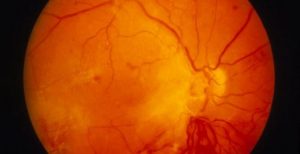
One of the complications of diabetes is microvascular changes to the back of the eye (the retina) called diabetic retinopathy.
What is Diabetic Retinopathy?
Diabetic retinopathy is rare in the first few years after a diagnosis of type 1 diabetes or prior to puberty, however over the next 2 decades after diagnosis, most people with type 1 diabetes will develop some form of retinopathy. Studies have found that approximately 80% of patients with type 1 diabetes will have some retinal changes 15 years after diagnosis. However there are many stages of diabetic retinopathy and this statistic should not be alarming but instead used to understand the importance of eye checks and blood sugar level control.
The early stages of diabetic retinopathy (non-proliferative diabetic retinopathy or NPRD) normally do not affect the vision. Blood vessels in the retina begin to close and stop transporting blood, and importantly oxygen, as well as they should. Microaneurysms and hard exudates deposit themselves in the retina. In more serious and progressive cases of diabetic retinopathy (Proliferative diabetic retinopathy or PDR) new blood vessels grow due to the lack of oxygen from the old closed vessels. These new blood vessels can cause problems with leaking of blood and result in swelling of the retina leading to significantly reduced vision. New blood vessels can also grow at the front of the eye and cause neovasular glaucoma which can cause pain and blindness.
How Can I Protect My Eyes?
Diabetic retinopathy progresses with poor blood sugar level control. It is important to monitor sugar levels and control adequately with medications to reduce the risk of diabetic retinopathy progression. Annual eye checks starting from diagnosis are an important way to reduce the risk of vision loss. If proliferative changes of the retina are found, ophthalmologists can use laser therapy to control blood vessel growth. Laser therapy does compromise side/peripheral vision so diet and medication control to prevent retinopathy should be a patient’s first priority.
Diabetes can affect the blood vessels of the eye and in many other parts of the body that we cannot visualise including the kidneys and heart. A simple eye check can give your doctor a good idea of the health of your whole body.
